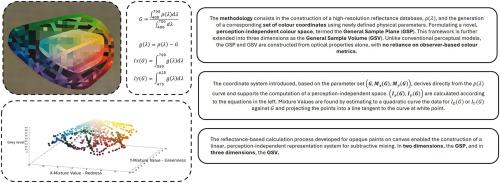预测减色混合的物理基础模型:对感知独立的框架
IF 4.2
3区 工程技术
Q2 CHEMISTRY, APPLIED
引用次数: 0
摘要
这项工作开发了一个物理基础模型,用于预测独立于视觉感知的颜料混合颜色。中心目标是确定内在的、可测量的参数,从而实现对颜色结果的准确和线性预测,通过8421个人工制备样品的数据集进行验证,包括43种基础颜料及其二元混合物,包括颜料间和颜料白色。要实现这一目标,需要追求三个相互关联的目标。首先,构建高分辨率反射率数据库ρ(λ),并使用新定义的物理参数生成相应的一组颜色坐标。其次,提出了一种新的、与感知无关的色彩空间,称为一般样本平面(GSP),其中每个颜料样本G都由三重态(G,Mx(G),My(G))唯一地表示。该框架进一步扩展到三个维度,即一般样本量(GSV)。与传统的感知模型不同,GSP和GSV仅由光学特性构建,而不依赖于基于观察者的颜色度量。第三,通过分析GSP中颜料混合物及其各自的美白阶段所追踪的轨迹的线性度来评估该坐标系的预测有效性。结果证实,颜料-颜料和颜料-白色这两种成分的混合物在这个空间中描述了高度线性的路径(达到R2 >; 0.99),即使在广谱域也具有最小的色度失真。此外,基于排除中间混合的插值精度定量评价显示,GSP空间的ΔE值较低(ΔE≤1.0),其中ΔE表示预测坐标与测量坐标之间的欧几里得距离,证实了模型的可靠预测性能。该模型为减色法系统中物理一致的颜色预测提供了可扩展的定量基础,在颜料配方、数字校准和有色材料的光学建模中具有潜在的应用。本文章由计算机程序翻译,如有差异,请以英文原文为准。

A physically grounded model for predicting subtractive colour mixing: towards a perception-independent framework
This work develops a physically grounded model for predicting pigment mixture colours that operates independently of visual perception. The central objective is to identify intrinsic, measurable parameters that enable accurate and linear predictions of colour outcomes, validated through a dataset of 8421 manually prepared samples, including 43 base pigments and their binary mixtures, both inter-pigment and pigment-white.
To achieve this, three interconnected goals are pursued. First, the construction of a high-resolution reflectance database, , and the generation of a corresponding set of colour coordinates using newly defined physical parameters. Second, the formulation of a novel, perception-independent colour space, termed the General Sample Plane (GSP), in which each pigment sample G is uniquely represented by the triplet . This framework is further extended into three dimensions as the General Sample Volume (GSV). Unlike conventional perceptual models, the GSP and GSV are constructed from optical properties alone, with no reliance on observer-based colour metrics. Third, the predictive validity of this coordinate system is evaluated by analysing the linearity of trajectories traced by pigment mixtures and their respective whitening stages in the GSP. The results confirm that mixtures of two components, both pigment-pigment and pigment-white, describe highly linear paths in this space (reaching R2 > 0.99), with minimal chromatic distortion even across broad spectral domains. Additionally, quantitative evaluation of interpolation accuracy, based on excluded intermediate mixtures, showed low ΔE values (ΔE ≤ 1.0) in the GSP space, where ΔE represents the Euclidean distance between predicted and measured coordinates, confirming the model's reliable predictive performance. The model offers a scalable, quantitative basis for physically consistent colour prediction in subtractive systems, with potential applications in pigment formulation, digital calibration, and optical modelling of coloured materials.
求助全文
通过发布文献求助,成功后即可免费获取论文全文。
去求助
来源期刊

Dyes and Pigments
工程技术-材料科学:纺织
CiteScore
8.20
自引率
13.30%
发文量
933
审稿时长
33 days
期刊介绍:
Dyes and Pigments covers the scientific and technical aspects of the chemistry and physics of dyes, pigments and their intermediates. Emphasis is placed on the properties of the colouring matters themselves rather than on their applications or the system in which they may be applied.
Thus the journal accepts research and review papers on the synthesis of dyes, pigments and intermediates, their physical or chemical properties, e.g. spectroscopic, surface, solution or solid state characteristics, the physical aspects of their preparation, e.g. precipitation, nucleation and growth, crystal formation, liquid crystalline characteristics, their photochemical, ecological or biological properties and the relationship between colour and chemical constitution. However, papers are considered which deal with the more fundamental aspects of colourant application and of the interactions of colourants with substrates or media.
The journal will interest a wide variety of workers in a range of disciplines whose work involves dyes, pigments and their intermediates, and provides a platform for investigators with common interests but diverse fields of activity such as cosmetics, reprographics, dye and pigment synthesis, medical research, polymers, etc.
 求助内容:
求助内容: 应助结果提醒方式:
应助结果提醒方式:


